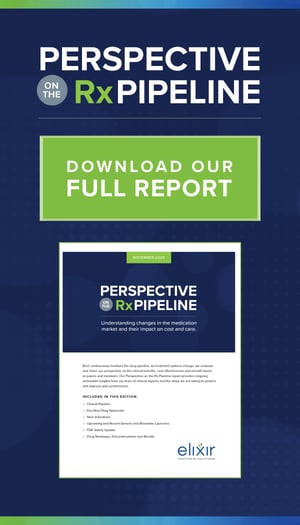 From a revolutionary treatment that could delay or prevent the onset of type 1 diabetes to the continuing effects of the COVID-19 pandemic, there are a number of pipeline developments to watch for in the coming year. Learn about the top six developments in this edition of Perspective on the Rx Pipeline.
From a revolutionary treatment that could delay or prevent the onset of type 1 diabetes to the continuing effects of the COVID-19 pandemic, there are a number of pipeline developments to watch for in the coming year. Learn about the top six developments in this edition of Perspective on the Rx Pipeline.
Perspective on the Rx Pipeline
1. Increasing Orphan Drug Market
Orphan drugs are used to treat rare diseases and conditions. Programs such as the Food & Drug Administration's (FDA's) Orphan Drug Designation are designed to incentivize sponsors to develop drugs for these uncommon diseases that otherwise may be overlooked for more profitable or broader population-impacting medications.[1] The program is working well and orphan drug designations have become fairly numerous. As of December 1, there were 73 FDA orphan drugs/indications approved for 2020 and these approvals do not appear to be slowing down in the near future. With the high cost of these medications and limited options for the conditions they treat, utilization management and formulary considerations will need to be applied.
2. Continual Development of Gene Therapy
Genetic targets for drug therapy are ever increasing. Gene therapy involves ex vivo and in vivo modification of genes to replace or modify erroneous genes with healthy functioning exogenous genes in the patient.[2, 3] The ultimate goal of gene therapy is to prevent or cure a disease or disorder. Some gene therapies may not fully cure a patient, yet still provide clinical benefit. There are other similar therapies, such as chimeric antigen receptor (CAR) T-cell and antisense oligonucleotide-based therapies. Gene editing, which we discussed in last year's "Top 10 Developments to Watch in 2020," is also making rapid advancements; however, currently there are no FDA-approved gene editing therapies.
Recently approved gene therapies include Zolgensma for spinal muscular atrophy and Luxturna for treatment of a rare inherited form of blindness (RPE65-mutation-associated retinal dystrophy). The near future drug pipeline consists of multiple gene therapy products that introduce genes or exogenous genes into the patient. See the full report for details on potential upcoming gene therapies.
3. Revolutionary Type 1 Diabetes Drug that Could Delay or Prevent Onset
Type 1 diabetes (T1D) progresses through two symptomatic stages prior to the development of clinical diabetes and the need for insulin. The first stage is the development of antibodies, with the second stage being dysglycemia.[4] Teplizumab is a 14-day intravenous course in development designed to delay or potentially prevent the onset of T1D. In phase II clinical trials studying high-risk nondiabetics, the disease was diagnosed in 43% of participants, with a median time to diagnosis of 48.4 months. Comparatively, the placebo group had a diagnosis in 72%, with a median time to diagnosis of 14.4 months.[5] According to the manufacturer, Provention Bio, findings also showed patients treated with teplizumab maintained C-peptide levels, a marker of endogenous insulin production, while those in the placebo group had a marked decrease in this lab value.[6]
There are no FDA-approved drugs for prevention of T1D. Standard of care is lifelong injections of insulin. The potential delay or prevention of disease onset provided by teplizumab could allow patients years without additional insulin injections.
4. New Injectable Therapies for Atopic Dermatitis
The standard of care for atopic dermatitis is topical therapy. However, if it is severe enough and patients have failed on topical therapy, injectable medication is now available with the additional indication granted to Dupixent® (dupilumanb), an IL-4/IL-13 antagonist, in May 2020. This was the first monoclonal antibody indicated for use in atopic dermatitis.[7-9]
Similar to Dupuxient, tralokinumab is an every other week subcutaneous injection in development. However, this medication has a novel target of IL-13 inhibition for atopic dermatitis. IL-13 inhibits inflammation pathways.[10] This inhibition leads to desensitization of the immune system, which will prevent/resolve disease flares.
Recent studies of Dupixent users has potentiated a link between inflammatory bowel disease and rheumatoid arthritis, hypothesized to be caused by inhibition of IL-4.[11, 12] Further data will be needed to confirm this newly emerging information and it will be interesting to see if tralokinumab bypasses these side effects with its more selective mechanism of action.
5. COVID-19 Vaccine Challenges and Long-Term Effects
As of December 1, 2020, there are 13 phase III trials in the vaccine pipeline for COVID-19. There are three front runners for Emergency Use Authorization (EUA). Two candidates have already submitted EUA applications (see full report for details). With these vaccines nearing completion, the problem shifts from vaccine development to dissemination of these products to the general public. Some vaccines in development are unstable unless adequate temperatures are maintained. During transport, there is a very real risk of the vaccines becoming damaged due to breaches in the cold chain storage. The cold chain storage problem is further exacerbated by pharmacies/hospitals/clinics not all having adequate refrigeration to maintain vaccine stability. Vaccines are anticipated to be disseminated in phases starting in December 2020.
There have also been some long-term effects to the COVID-19 pandemic. Approximately 10% of people who test positive for COVID-19 continue to have persistent symptoms after three weeks and have been named long haulers.[13] Additionally, at the start of the pandemic, primary care visits were delayed, rescheduled or switched to virtual care, leading to a reduction in healthcare services for some chronic conditions (see the full report for details on the most impacted conditions). Chronic disease state management is key to reducing hospitalization for acute need (i.e., heart attack and stroke). In 2021, we may see more impact from delays and gaps in care and interruptions to drug adherence.
Please note, prior to publication, the Pfizer/BioNTech vaccine received EUA from the FDA. Distribution and administration has begun.
6. 2020 Pipeline Delays and Complete Response Letters
With the global pandemic, clinical trials had to be halted and restarted to ensure the safety of participants and researchers, leading to some delays in FDA approvals. For some of these products the FDA has issued complete response letters (CRL), delaying possible approval. A CRL is a letter sent from the FDA to the drug manufacturer (applicant) with the rationale for why the product will not be approved and a possible recommendation for action the applicant may take to remediate the FDA’s concern. Deficiencies in the application are highlighted and can range from efficacy and safety to manufacturing issues.[14] Read the full report for details on some impactful pipeline medications where approval has been delayed, requiring additional steps by the manufacturer before FDA reconsideration.
Download the full report for more information on all of these developments.
[1] Office of Orphan Products Development. U.S. Food and Drug Administration. (2019). Retrieved 1 December 2020, from https://www.fda.gov/about-fda/office-clinical-policy-and-programs/office-orphan-products-development.
[2] What is Gene Therapy? How Does It Work? U.S. Food and Drug Administration (FDA). (2017). Retrieved 3 December 2020, from https://www.fda.gov/consumers/consumer-updates/what-gene-therapy-how-does-it-work.
[3] Bulaklak, K., & Gershbach, C. (2020). The once and future gene therapy. Nature, 11(5820). https://doi.org/10.1038/s41467-020-19505-2
[4] Insel RA, Dunne JL, Atkinson MA, et al. Staging presymptomatic type 1 diabetes: a scientific statement of JDRF, the Endocrine Society, and the American Diabetes Association. Diabetes Care 2015;38:1964-1974.
[5] Herold, K. (2019). An Anti-CD3 Antibody, Teplizumab, in Relatives at Risk for Type 1 Diabetes. N Engl J Med, 381, 603-613.
[6] Provention Bio. (2020). Provention Bio’s Teplizumab Continued to Significantly Delay the Onset of Insulin-Dependent Type 1 Diabetes (T1D) in Presymptomatic Patients [Press release].
[7] Eichenfield, L., Tom, W., Berger, T., Harrod, C., Smith Begolka, W., & Sidbury, R. (2014). Guidelines of care for the management of atopic dermatitis: Section 2. Management and treatment of atopic dermatitis with topical therapies. Journal of the American Academy of Dermatology,71(1), 116-132. https://doi.org/10.1016/j.jaad.2014.03.023
[8] Eichenfield, L., Tom, W., Berger, T., Harrod, C., Smith Begolka, W., & Sidbury, R. (2014). Guidelines of care for the management of atopic dermatitis: Section 3. Management and treatment with phototherapy and systemic agents. Journal of the American Academy of Dermatology,71(1), 327-349. https://doi.org/10.1016/j.jaad.2014.03.030
[9] FDA approves new eczema drug Dupixent. News release. FDA; March 28, 2017. Accessed November 19, 2020. https://www.fda.gov/news-events/press-announcements/fda-approves-new-eczema-drug-dupixent
[10] Apter, A. (2019). The tralokinumab story: Nothing is ever simple. Journal of Allergy and Clinical Immunology, 143(4), 1336-1338.Silverberg J. Efficacy and safety of tralokinumab with concomitant topical corticosteroid in adult patients with moderate-to-severe atopic dermatitis: results from the 32-week phase 3 ECZTRA 3 trial. Presented at: American Academy of Dermatology Virtual Meeting Experience 2020; June 10-12, 2020.
[11] DeWijs LE, der Waa JD, deJong PH, Hijnen DJ. Acute arthritis and arthralgia as an adverse drug reaction to dupilumab. Clin Exp Dermatol 2019 Jul 19 [Epub ahead of print].
[12] Willsmore ZN, Woolf RT, Hughes C, Menon B, et al. Development of inflammatory arthritis and enthesitis in patients on dupilumab: A case series. Br J Dermatol 181: 1068-1070
[13] COVID Symptom Study. How long does COVID-19 last? Kings College London, 2020. https://covid19.joinzoe.com/post/covid-long-term?fbclid=IwAR1RxIcmmdL-EFjh_aI-.
[14] CFR - Code of Federal Regulations Title 21. Accessdata.fda.gov. (2020). Retrieved 3 December 2020, from https://www.accessdata.fda.gov/scripts/cdrh/cfdocs/cfcfr/cfrsearch.cfm?fr=314.110.

